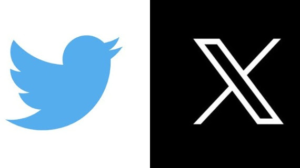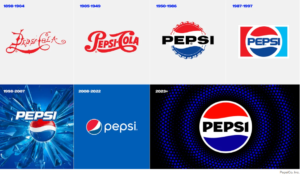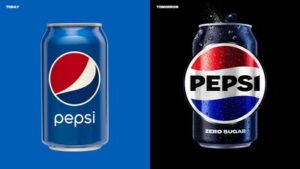Brand design trends – simple, authentic, being real
Disruptive brand design: focus on being real with simplicity, authenticity, vibrant color, and connectivity to people. These and related trends encapsulate multi-million-dollar changes to corporate brands and logos over the past year or so. In late July, Following a rebranding trend (and separately, the competitive launch of Threads), Twitter and Elon Musk surprised the tech world with an unexpected brand transformation from an iconic bird image to a stylized X, reflecting Musk’s core companies (e.g. SpaceX).
Inviting fans to suggest a new logo, Musk (and new CEO Linda Yaccarino) announced online that the reimagined Twitter logo would be”Going with minimalist art deco.”
Yaccarino went further, stating on the Twitter/X platform: “X is the future state of unlimited interactivity – centered in audio, video, messaging, payments/banking – creating a global marketplace for ideas, goods, services, and opportunities. Powered by AI, X will connect us all in ways we’re just beginning to imagine.”
Earlier in the spring, Pepsi weighed in with a major design shift, with the company making its first major rebrand in 15 years. Generally well-received and embraced by lovers of things fizzy, the Pepsi announcement followed on major rebrands this year from Nokia and Burberry. Burger King kicked in with a new, semi-retro design back in 2021, which has also been surprisingly well-received.

Basic changes in brand design
Apart from the Twitter/X 24-hour turnaround, what’s driving these expensive and far-reaching changes? Simply put: data-driven strategy. Brands represent a collective summary of thoughts, perceptions and emotions, and successful brand imagery and logos reflect and capture that mental assembly.

Ironically, as numerous experts attest, an era of imperfection has moved in. Research shows that consumers prefer real, authentic products, services and experiences that reflect reality. Products and services presented in simple, real-life scenarios suggest authenticity and accessibility.
ADWEEK’s Lee Rolston explains that major corporate retail brands appear to be “opting for more definitive, classic identities,” adding that “Gone are the days of flares, drop shadows, faux spritz, and claim overloads.” Even through it was a dramatically fast turnaround, Twitter/X’s new logo sports a deliberately minimalist look and feel (which will likely be refined over the coming weeks and months).
Further, Twitter/X represents a return to original tech concepts. As reported by the Wall Street Journal, “Twitter’s incoming logo harks back to Musk’s former online banking startup, X.com, which later became PayPal after a merger with another firm. He tweeted last year that buying Twitter would bring him closer to fulfilling the ‘original X.com vision.’”
Burger King, together with its new CEO, tossed out its burger-encased circle logo, with ad agency JKR noting that “we set out to make the brand feel less synthetic and artificial, and more real, craveable and tasty.”
Changes in product can drive design
The new brand image launches often coincide with product improvements and redesigns. With Burger King slipping in market share, it responded as research showed that its target market wanted more healthy foods. Burger King responded by tossing out 120 ingredients from its food product lineup, including numerous food dyes and corn fructose syrup, long a major “bad guy” among Gen Z and other generational foodies. In its new brand lift, Pepsi announced that new mainstream Pepsi would feature 57% less sugar, but “still taste great.”
What are key elements in new brand design? The Wall Street Journal interviewed brand expert Debbie Millman, who was part of the Burger King design team when the company first launched its burger logo some 20 years ago.
Eye design
What are key design considerations? Millman notes that people see color first, then shape, followed by numbers and words.
Accordingly, the JKR team again emphasized orange to reflect the burger bun, and red to relate to fresh tomatoes in the company’s franchise leader, The Whopper.
Common research trends that drive contemporary rebrands include a need expressed by consumers who want simple, creative images that they can relate to. This implies minimalism, where imagery and product photography are accessible, inspiring, even beautiful.
Hand-drawn logos and illustrations are making a comeback, again bringing a sense of authenticity, “realness” and thoughts of “simpler times.”
Boldness in design also works, especially if it’s coupled with an “eco-look” that suggests a corporate commitment to positive environmental impact. A friendly brand voice can contribute here and resonate with younger audiences.
Time for a rebrand?
As markets and preferences shift, many companies and organizations can benefit from a rebrand. Visually attractive elements that reflect positive changes and heretofore minimized benefits can elevate awareness, reposition a company for success, and build new enthusiasm – huge consumer brands like Pepsi and Burger King have already achieved this.
A few thoughts as you consider a change up:
- Before you embark on visually sculpting a new brand, conduct a formal brand audit. What kind of brand equity do you have? What elements are considered beneficial? What elements seem stale? What are your key messages? Do they still resonate with your target audience and key groups?
- Take a long look at your competitors. What updates, if any, have been made recently? How are they using their visual brand elements (check out moat.com for ideas and comparisons)
- Conduct formal research with your customers, influencers and stakeholders to sample preferences. Put together an online survey, segment by audience and gather information.
- When you have some ideas about your new brand and logo designs, take them for a test drive with a few focus groups. Don’t forget to include internal considerations, especially your people in the field and customer sales and experience reps.
- Don’t forget that design is great, but a successful brand lift includes an emphasis on and a reflection of corporate/organizational personality, values, and traits.
- Anchor your brand lift to customer and stakeholder expectations. Remember that what your customer or influencer likes is critically important.
With times of economic turbulence, it is the season to shore up your brand. Want more about brand lift and strategic creative design? Contact us at MEK.
Like what you’re reading? Click here to subscribe to our Insights newsletter.
By Jamie Snyder, a long-time brand advocate at MEK, whose experience includes brand development for the $100 million WestGate@Crane Technology Park and numerous other MEK tech and healthcare clients.
